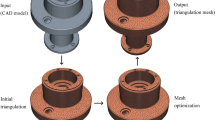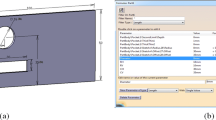Abstract
This paper proposes a method for predicting the complexity of meshing computer aided design (CAD) geometries with unstructured, hexahedral, finite elements. Meshing complexity refers to the relative level of effort required to generate a valid finite element mesh on a given CAD geometry. A function is proposed to approximate the meshing complexity for single part CAD models. The function is dependent on a user defined element size as well as on data extracted from the geometry and topology of the CAD part. Several geometry and topology measures are proposed, which both characterize the shape of the CAD part and detect configurations that complicate mesh generation. Based on a test suite of CAD models, the function is demonstrated to be accurate within a certain range of error. The solution proposed here is intended to provide managers and users of meshing software a method of predicting the difficulty in meshing a CAD model. This will enable them to make decisions about model simplification and analysis approaches prior to mesh generation.











Similar content being viewed by others
References
Butlin G, Stops C (1996) CAD data repair. In: Proceedings of 5th international meshing roundtable, pp 7–12
Cheney D (1998) CAD model quality holds the key for analysis. In: Proceedings 7th International Meshing Roundtable, pp 539–546
Mezentsev A (1999) Methods and Algorithms of Automated CAD Repair for Incremental Surface Meshing. Proceedings 8th International Meshing Roundtable, pp 299–309
http://www.spatial.com, April 2003
http://www.eds.com/products/plm/parasolid/portfolio/bodyshop.shtml, April 2003
http://www.cadfix.com, April 2003
http://www.cadiq.com, April 2003
White D, Leland R, Saigal S, Owen S (2001) The meshing complexity of a solid: an introduction. In: Proceedings of 10th International meshing roundtable, pp 373–384
Steinbrenner J, Wyman N, Chawner J (2000) Fast surface meshing on imperfect cad models. In: Proceedings 9th International meshing roundtable. pp 33–41
Marcum D, Gaither A (1999) Unstructured surface grid generation using global mapping and physical space approximation. In: Proceedings 8th International meshing roundtable, pp 397–406
Sheffer A, Blacker T, Clements J, Bercovier M (1997) Virtual topology operators for meshing. In: Proceedings 6th International meshing roundtable, pp 49–66
Sheffer A, Blacker T, Bercovier M (1997) Clustering: automated detail suppression using virtual topology. Trends in unstructured mesh generation. ASME 220:57–64
Armstrong C, Bridgett S, Donaghy R, McCune R, McKeag R, Robinson D (1998) Techniques for interactive and automatic idealisation of CAD models. Num Grid Generation Comp Field Sim, pp 643–662
Blacker T, Sheffer A, Clements J, Bercovier M (1997) Using virtual topology to simplify the mesh generation process. Trends in unstructured mesh generation. ASME 200:45–50
Tautges T (2001) Automatic detail reduction for mesh generation applications. In: Proceedings 10th International meshing roundtable, pp 407–418
Mobley A, Carroll M, Canann S (1998) An object oriented approach to geometry defeaturing for finite element meshing. In: Proceedings 7th International meshing roundtable, pp 547–563
Armstrong C, Robinson D, McKeag R, Li T, Bridgett S, Donaghy R, McGleenan C (1995) Medials for meshing and more. In: Proceedings 4th International meshing roundtable, pp 277–288
Sheffer A, Etzion M, Rappoport A, Bercovier M (1998) Hexahedral mesh generation using the embedded voronoi graph. In: Proceedings 7th International meshing roundtable, pp 347–364
Lu Y, Gadh R, Tautges TJ (1999) Volume decomposition and feature recognition for hexahedral mesh generation. In: Proceedings 8th International meshing roundtable, pp 269–280
Schneiders R, Schindler R, Weiler F (1996) Octree-based generation of hexahedral element meshes. In: Proceedings 5th International roundtable pp 205–216
Tautges T, Blacker T, Mitchell S (1996) The whisker weaving algorithm: a connectivity-based method for constructing all-hexahedral finite element meshes. Int J Num Methods Eng 39:3327–3349
Folwell N, Mitchell S (1998) Reliable whisker weaving via curve contraction. In: Proceedings 7th International meshing roundtable, pp 365–378
Blacker T, Meyers R (1993) Seams and wedges in plastering: a 3D hexahedral mesh generation algorithm. Eng Comput 2:83–93
Mitchell S (1998) The all-hex geode-template for conforming a diced tetrahedral mesh to any diced hexahedral mesh. In: Proceedings 7th International meshing roundtable, pp 295–305
Muller- Hannemann M (1998) Hexahedral mesh generation by successive dual cycle elimination. In: Proceedings 7th International meshing roundtable, pp 365–378
Ymakawa S, Shimada K (2001) Hexhoop: modular templates for converting a hex-dominant mesh to an all-hex mesh. In: Proceedings 10th International meshing roundtable, pp 235–246
Cook W, Oaks W (1983) Mapping methods for generating three-dimensional meshing. Comput Mech Eng 1:67–72
White D, Mingwu L, Benzley S, Sjaardema G (1995) Automated hexahedral mesh generation by virtual decomposition. In: Proceedings 4th International meshing roundtable, pp 165–176
Blacker T (1996) The cooper tool. In: Proceedings 5th International meshing roundtable, pp 13–30
White D, Tautges T (2000) Automatic scheme selection for toolkit hex meshing. Int J Num Methods Eng 49:127–144
Mitchell S (1997) High fidelity interval assignment. In: Proceedings 6th International meshing roundtable, pp 33–44
Tautges T (2000) The common geometry module (CGM): a generic, extensible geometry interface. In: Proceedings 9th International meshing roundtable 337–348
Blacker T (1991) Paving: a new approach to automated quadrilateral mesh generation. Int J Num Methods Eng 32:811–847
Owen S, Staten M, Canann S, Saigal S (1999) Q-Morph: an indirect approach to advancing front quad meshing. Int J Num Methods Eng 44:1317–1340
Mitchell S (1997) Choosing corners of rectangles for mapped meshing. In: 13th Annual symposium on computational geometry, ACM Press, pp 87–93
Shepherd J (2003) CUBIT mesh generation toolsuite. http://cubit.sandia.gov.
Acknowledgements
The authors wish to acknowledge Sandia National Laboratories for providing funding and motivation for this project. Sandia National Laboratories is a multi-program laboratory operated by Sandia Corporation, a Lockheed Martin Company, for the United States Department of Energy under contract DE-AC04-94-AL85000. Additionally, we wish to thank ANSYS Inc. for providing many of the CAD models that were included in the test suite.
Author information
Authors and Affiliations
Corresponding author
Rights and permissions
About this article
Cite this article
White, D.R., Saigal, S. & Owen, S.J. Meshing complexity: predicting meshing difficulty for single part CAD models. Engineering with Computers 21, 76–90 (2005). https://doi.org/10.1007/s00366-005-0002-x
Received:
Accepted:
Published:
Issue Date:
DOI: https://doi.org/10.1007/s00366-005-0002-x




